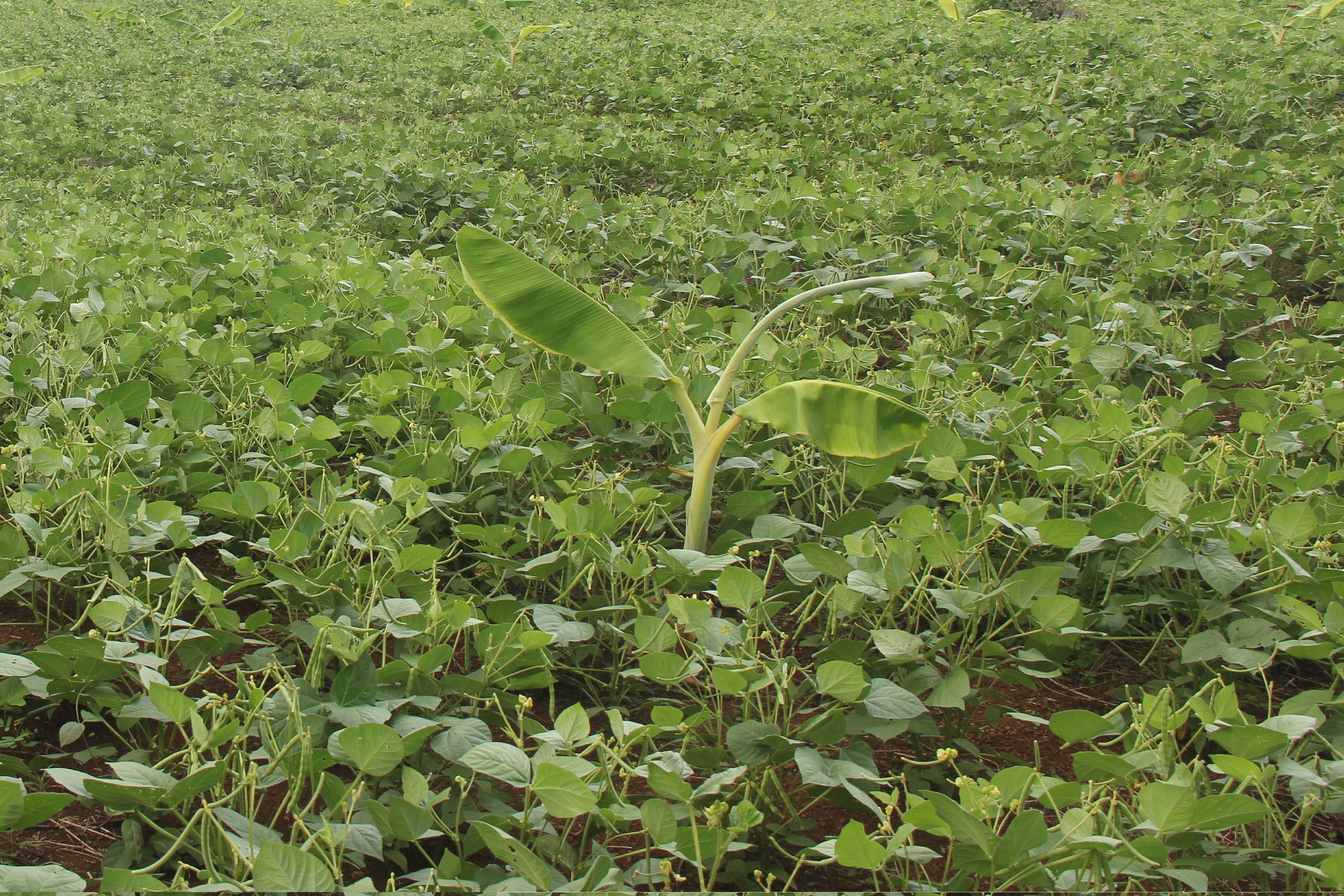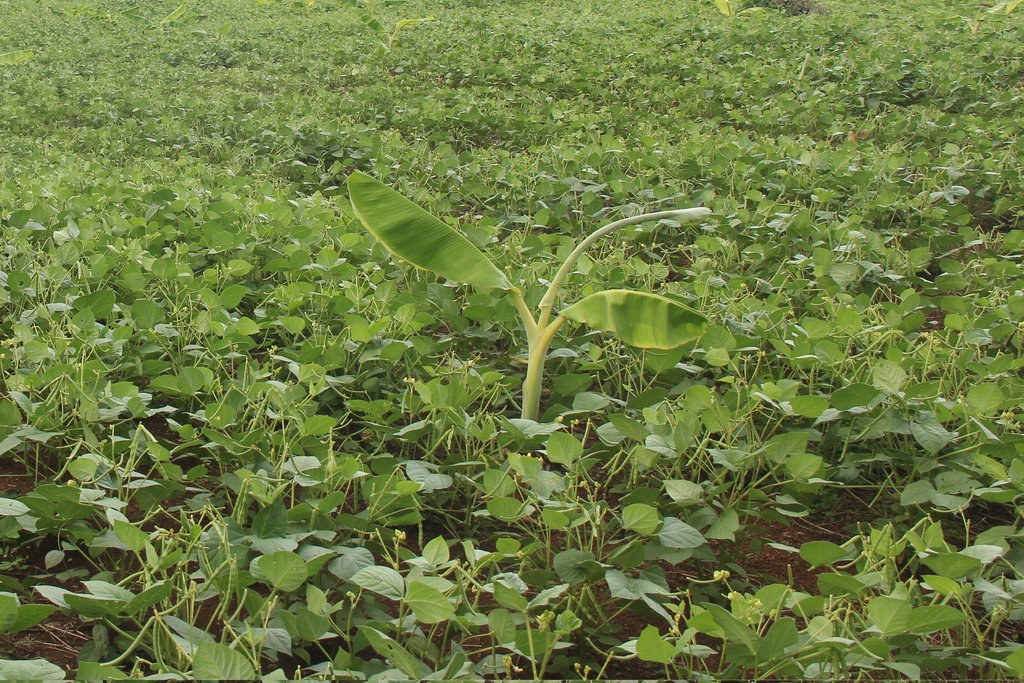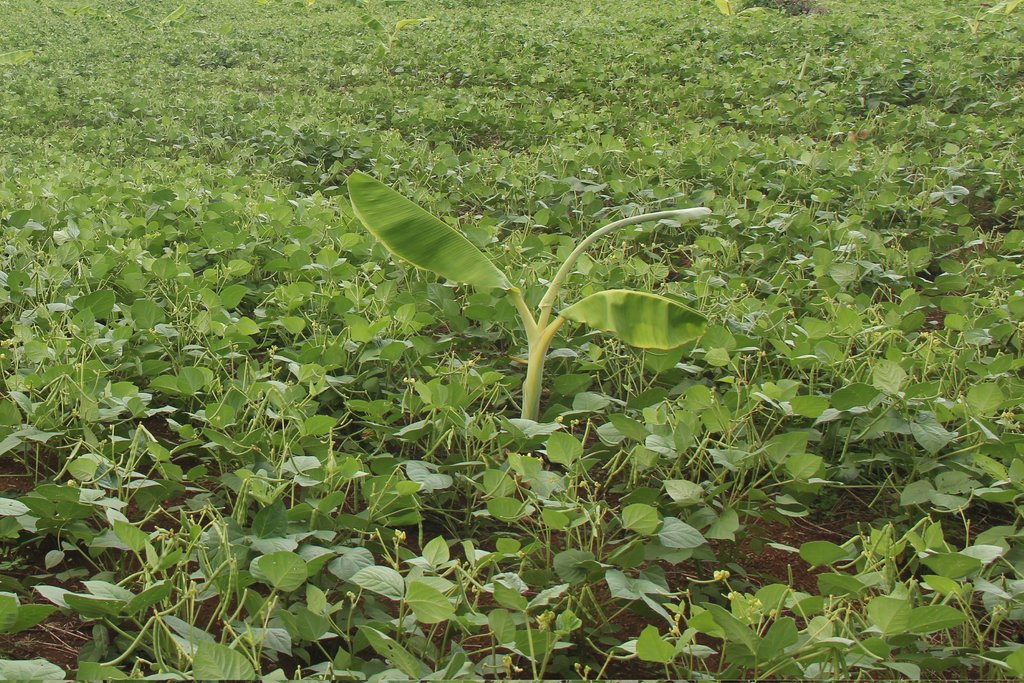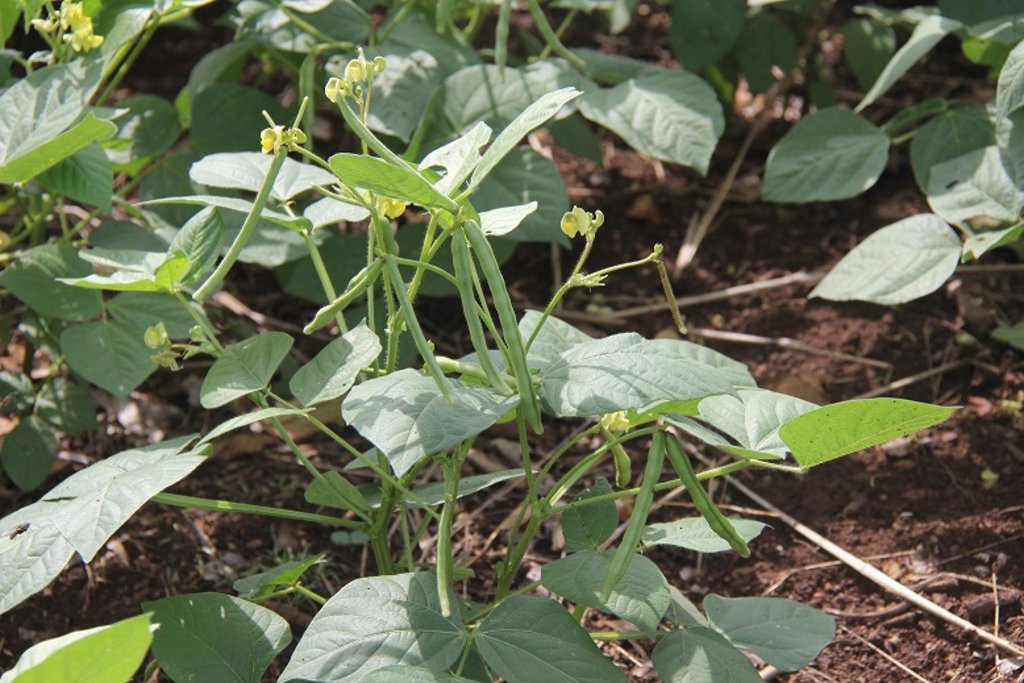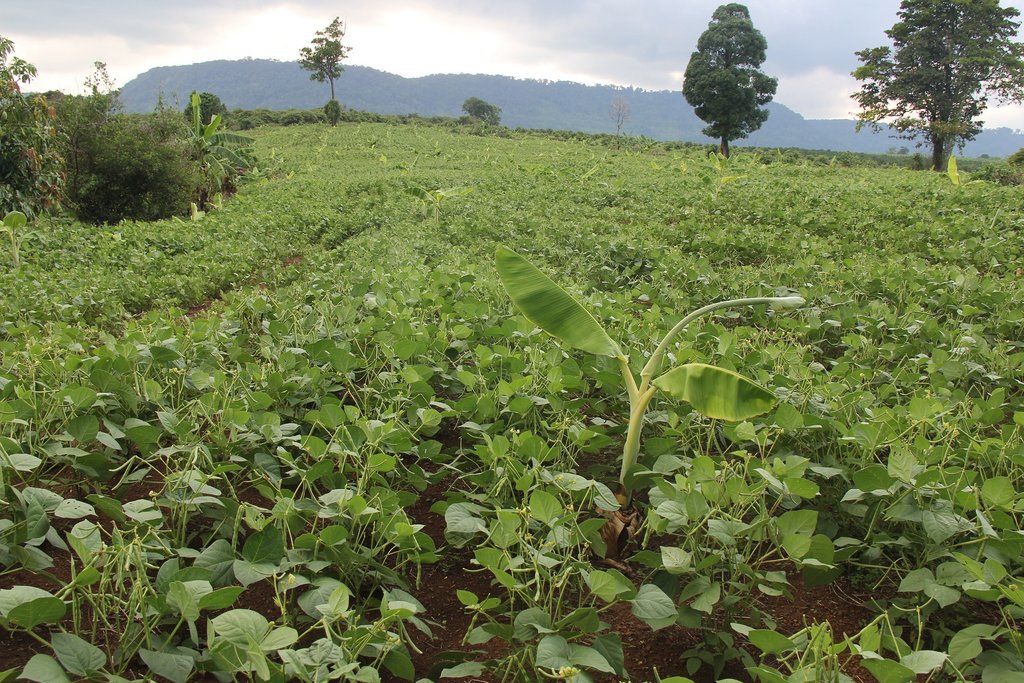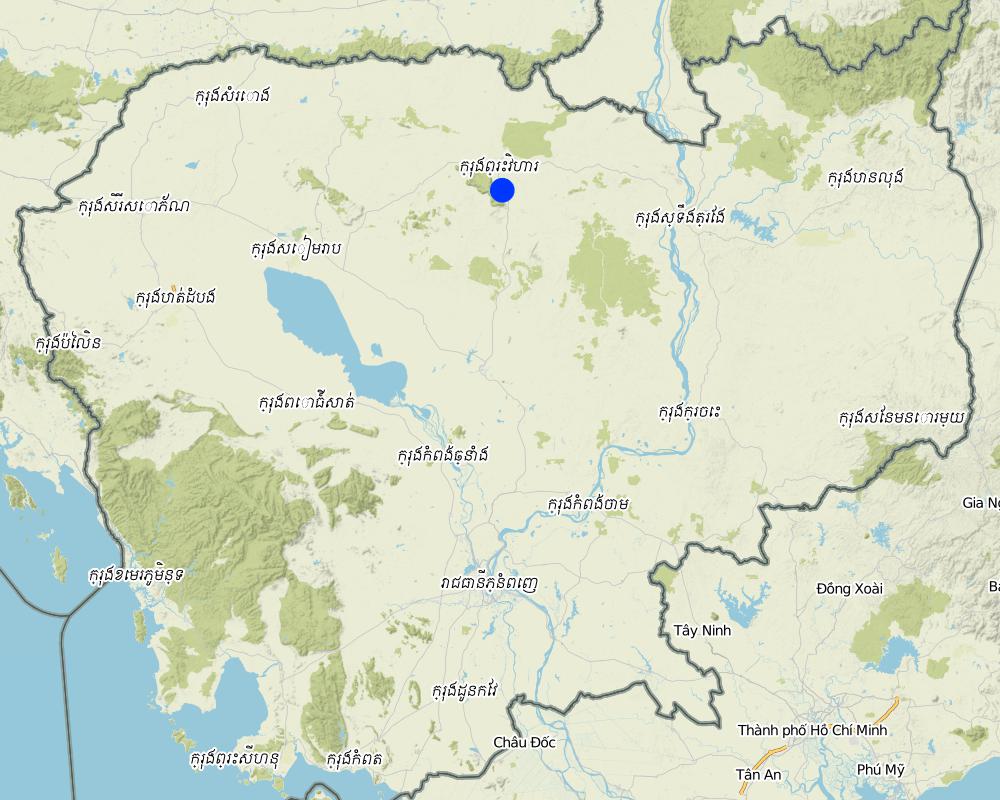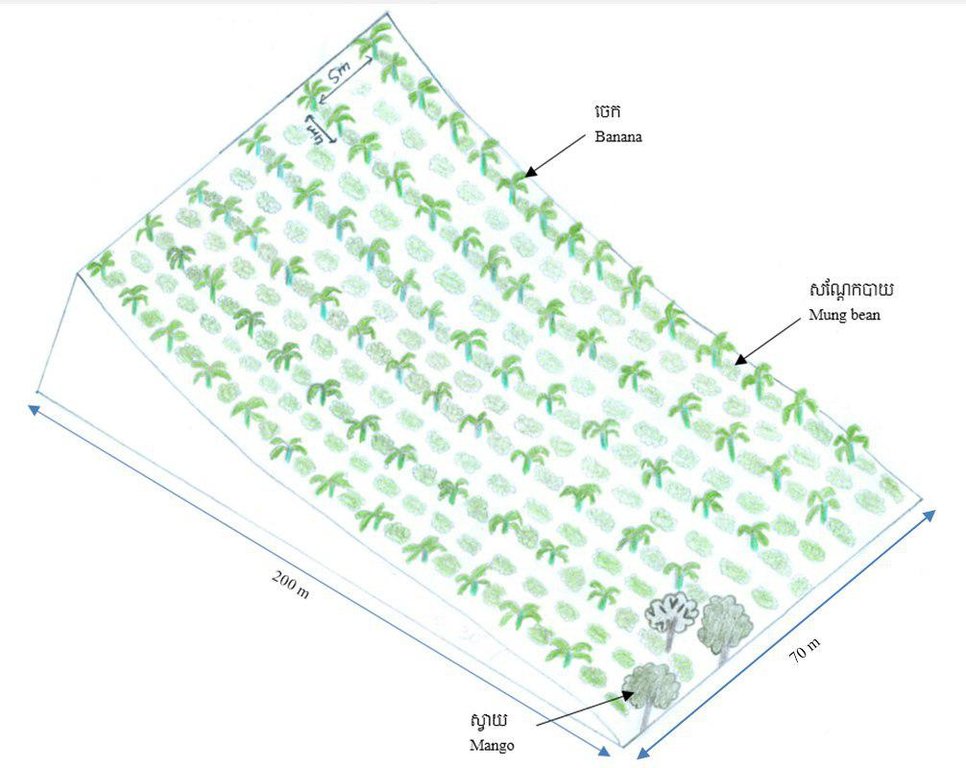ការដាំសណ្ដែកបាយជាមួយដំណាំចេកនៅតំបន់ខ្ពង់រាប [Cambodia]
- Creation:
- Update:
- Compiler: SOEM DA
- Editors: Sophea Tim, Navin Chea, Sok Pheak
- Reviewers: Nimul CHUN, Stephanie Jaquet, Nicole Harari, Ursula Gaemperli, Alexandra Gavilano
ការដាំសណ្ដែកបាយ
technologies_1890 - Cambodia
View sections
Expand all Collapse all1. General information
1.2 Contact details of resource persons and institutions involved in the assessment and documentation of the Technology
Key resource person(s)
land user:
សុភា ម៉ុន
កសិករ
Cambodia
ប្រធានការិយាល័យកសិកម្មស្រុកគូលែន:
មន្ត្រីការិយាល័យកសិកម្មស្រុកជាំក្សាន្ត:
ឆ្លាត ប្រាជ្ញ
ការិយាល័យកសិកម្មស្រុកជាំក្សាន្ត
Cambodia
ប្រធានការិយាល័យកសិកម្មស្រុករវៀង:
គុយជន ចេង
ការិយាល័យកសិកម្មស្រុករវៀង
Cambodia
Name of project which facilitated the documentation/ evaluation of the Technology (if relevant)
Scaling-up SLM practices by smallholder farmers (IFAD)Name of the institution(s) which facilitated the documentation/ evaluation of the Technology (if relevant)
Royal University of Agriculture (RUA) - Cambodia1.3 Conditions regarding the use of data documented through WOCAT
The compiler and key resource person(s) accept the conditions regarding the use of data documented through WOCAT:
Ja
1.4 Declaration on sustainability of the described Technology
Is the Technology described here problematic with regard to land degradation, so that it cannot be declared a sustainable land management technology?
Nee
2. Description of the SLM Technology
2.1 Short description of the Technology
Definition of the Technology:
ការដាំសណ្ដែកបាយនៅចន្លោះចេកជាការដាំដើម្បីបន្ថែមជីជាតិដល់ដី និងទទួលបានប្រាក់ចំណូលបន្ថែមកំឡុងពេលចេកមិនទាន់ផ្ដល់ផល។
2.2 Detailed description of the Technology
Description:
ដំណាំសណ្តែកបាយជាដំណាំមានកំពកឫសដែលបង្កើតឡើងដោយបាក់តេរីពួករីហ្សូប្សូមដែលមានសមត្ថភាពផ្ទុក និងស្រូបយកអាសូតពីបរិយាកាសដែលល្អសម្រាប់ដំណាំនៅជិត និងបន្ទាប់ពីប្រមូលផលរួចត្រូវបានភ្ជួរកប់ដើម្បីជាជំនួយដល់សារធាតុចិញ្ចឹមដល់ដី (CARDI, 2011)។ កាកសំណល់របស់សណ្តែកបាយដូចជា ដើម ស្លឹក សំបក ជាដើម គឺបានចូលរួមយ៉ាងសកម្មក្នុងប្រព័ន្ធបង្កើនគុណភាពដី ឬកែលម្អជីជាតិដីតាមរយៈការបង្កើនសារធាតុអាសូតដល់ដី។ ដំណាំសណ្តែកបាយភាគច្រើនដាំនៅ ខែមីនា ដោយបុកដាំ ជាជួរ និងមានចន្លោះគុម្ព (MAFF, 2005)។ រីឯដំណាំចេកជាដំណាំដែលផ្តល់សំណើមខ្ពស់មានប្រព័ន្ធឫសដែលធ្វើឱ្យដីធូរមានខ្យល់ចេញចូល និងសម្បូរជាតិមមោក។ ចំពោះការដាំចេកអាចដាំដោយជីករណ្តៅ ៣០សង់ទីម៉ែត្រ និងទំហំរណ្តៅ ០,៥ ម៉ែត្រ បួនជ្រុងហើយចន្លោះជួរ ២ម៉ែត្រ (Our Agricultural Market, 2017)។
លោកស្រី ម៉ុន សុភា រស់នៅតំបន់ខ្ពង់រាបក្នុងភូមិអណ្ដូងប្រេង ឃុំព្រះឃ្លាំង ស្រុកត្បែងមានជ័យ ខេត្តព្រះវិហារ ប្រទេសកម្ពុជា ត្រូវបានជ្រើសរើសក្នុងការសិក្សានេះដោយគាត់បានជ្រើសរើសបច្ចេកទេសដាំសណ្តែកបាយជាមួយដំណាំចេកដែលជាបច្ចេកទេសការគ្រប់គ្រងដីមួយដ៏ល្អ។
គោលបំណងមួយក្នុងចំណោមគោលបំណងជាច្រើននៃការដាំសណ្តែកបាយនៅចន្លោះដើមចេក គឺជួយបង្កើនជីជាតិដល់ដីធ្វើឱ្យដីកាន់តែប្រសើរឡើងតាមរយៈការទុកកាកសំណល់ដើមសណ្តែកនៅចន្លោះដើមចេកដែលជាដីទំនេរដើម្បីឱ្យវារលួយក្លាយជាជីសរីរាង្គ។ លើសពីនេះទៅទៀតសណ្តែកបាយបានដើរតួនាទីជាដំណាំគម្របដីផងដែរក្នុងការកាត់បន្ថយការហូរច្រោះដីស្រទាប់លើដោយសារទឹក និងការពារកុំឱ្យដុះស្មៅចង្រៃប្រជែងនឹងការដុះលូតលាស់របស់ដំណាំចេក។
ក្រៅពីបច្ចេកទេសនេះផ្តល់អត្ថប្រយោជន៍ជួយដល់ដី វាបានបង្កើនប្រាក់ចំណូលបន្ថែមដល់កសិករមុនពេលដែលចេកមិនទាន់ឱ្យផល។ ដំណាំចេកជាដំណាំអាយុកាលវែង ដូចនេះចន្លោះពេលចេកមិនទាន់បានផលដំណាំសណ្តែកបាយជាប្រភពចំណូលដ៏សំខាន់សម្រាប់ជីវភាពគ្រួសារ។ ដំណាំចេកអាចប្រមូលផលជាលើកដំបូងនៅពេលវាមានអាយុ ១០ខែ និងប្រមូលផលបានពេញលេញនៅពេលវាមានអាយុ ២ឆ្នាំឡើងទៅ ហើយធ្លាក់ទិន្នផលនៅឆ្នាំទី៦ ឬទី៧ ដែលចាប់ផ្តើមកាប់ចោល។ ចំណែកសណ្តែកបាយជាដំណាំអាយុកាលខ្លីអាចប្រមូលផល និងទទួលបានប្រាក់ចំណូលក្នុងរយៈពេល ៣ខែ ហើយអាចដាំបាន ២ដងក្នុងមួយរដូវ។ ជាទូទៅនៅពេលចេកមានអាយុប្រហែល ២ ឬ៣ឆ្នាំ គឺមិនអាចដាំសណ្តែកបាយបានទេ ដោយសារវាម្លប់មិនអាចឱ្យពន្លឺព្រះអាទិត្យចាំងចូលដល់ដំណាំក្រោមបាន។
ការដាំសណ្តែកបាយគាត់ប្រើពូជប្រមាណ ២២ គីឡូក្រាម នៅលើដីទំហំ ៧០×២០០ ម៉ែត្រហើយដាំតាមរយៈការបុកដាំគ្រាប់នៅចន្លោះដើមចេកដោយមិនធ្វើការព្រួសគ្រាប់នោះទេ ដោយសារការបុកដាំជាជួរជួយឱ្យមានលំហរគ្រប់គ្រាន់សម្រាប់ខ្យល់អាចចេញចូលបានល្អ និងបានទិន្នផលខ្ពស់។នៅក្នុងករណីសិក្សានេះកសិករដាំសណ្តែកបាយ និងបន្ទាប់ពីប្រមូលផលវា គាត់នឹងដាំសណ្តែកសៀងបន្តនៅខែកក្កដា ហើយមួយរដូវអាចដាំដំណាំប្រភេទសណ្តែកបាន ២ដង។ចេកត្រូវបានដាំដោយកាប់រណ្តៅជម្រៅ ០,៥ ម៉ែត្រ ទំហំរណ្តៅ ២០ ទៅ ៣០សង់ទីម៉ែត្រ បួនជ្រុង និងមានចន្លោះជួរ ៥ម៉ែត្រ ចន្លោះដើម ៤ម៉ែត្រ និងគួរដាំនៅខែកុម្ភៈ ព្រោះមិនទាន់មាន ភ្លៀងទើបកូនដុះល្អបើដាំខែភ្លៀងចេកងាយកើតជំងឺក្រាស៊ីហើយវាលូតលាស់មិនសូវល្អដូចដាំនៅខែប្រាំងទេ។
2.3 Photos of the Technology
2.5 Country/ region/ locations where the Technology has been applied and which are covered by this assessment
Country:
Cambodia
Region/ State/ Province:
ភូមិអណ្ដូងប្រេង ឃុំព្រះឃ្លាំង ស្រុកត្បែងមានជ័យ ខេត្តព្រះវិហារ
Specify the spread of the Technology:
- evenly spread over an area
If the Technology is evenly spread over an area, specify area covered (in km2):
0.014
If precise area is not known, indicate approximate area covered:
- < 0.1 km2 (10 ha)
Comments:
ផ្ទៃដីអនុវត្តបច្ចេកទេសនេះមានទំហំ ៧០ម៉ែត្រ× ២០០ម៉ែត្រ= ១៤,០០០ ម៉ែត្រការ៉េ ជាដីជួលគេក្នុងតម្លៃ ១លានរៀលក្នុងមួួយឆ្នាំ។
Map
×2.6 Date of implementation
If precise year is not known, indicate approximate date:
- less than 10 years ago (recently)
2.7 Introduction of the Technology
Specify how the Technology was introduced:
- as part of a traditional system (> 50 years)
Comments (type of project, etc.):
ធ្វើតាមគ្នា
3. Classification of the SLM Technology
3.1 Main purpose(s) of the Technology
- reduce, prevent, restore land degradation
- create beneficial economic impact
3.2 Current land use type(s) where the Technology is applied

Cropland
- Annual cropping
- Perennial (non-woody) cropping
Annual cropping - Specify crops:
- legumes and pulses - beans
- legumes and pulses - soya
Perennial (non-woody) cropping - Specify crops:
- banana/plantain/abaca
Number of growing seasons per year:
- 2
Specify:
ក្នុងមួយឆ្នាំដាំបាន ២ដង គឺសណ្ដែកបាយ នឹងសណ្ដែកសៀង ដាំបន្តរហូតចេកទទួលផល
Is intercropping practiced?
Ja
Comments:
សណ្ដែកបាយ/សណ្ដែកសៀង និងដំណាំចេក
ដង់ស៊ីតេនៃសត្វចិញ្ចឹម: មិនមានចិញ្ចឹមសត្វទេ
3.4 Water supply
Water supply for the land on which the Technology is applied:
- rainfed
Comments:
ពឹងលើទឹកភ្លៀងទាំងស្រុង
3.5 SLM group to which the Technology belongs
- improved ground/ vegetation cover
3.6 SLM measures comprising the Technology

agronomic measures
- A1: Vegetation/ soil cover
- A2: Organic matter/ soil fertility
- A3: Soil surface treatment
3.7 Main types of land degradation addressed by the Technology

soil erosion by water
- Wt: loss of topsoil/ surface erosion

biological degradation
- Bl: loss of soil life
3.8 Prevention, reduction, or restoration of land degradation
Specify the goal of the Technology with regard to land degradation:
- prevent land degradation
Comments:
ជាដីដែលមានជីជាតិល្អព្រោះដាំដំណាំនៅតែទទួលផលបានល្អ
4. Technical specifications, implementation activities, inputs, and costs
4.1 Technical drawing of the Technology
Technical specifications (related to technical drawing):
កសិករបានដាំសណ្ដែកបាយនៅចន្លោះដើមចេកនៅលើផ្ទៃដីទំហំ ៧០ម៉ែត្រ × ២០០ម៉ែត្រ= ១៤,០០០ម៉ែត្រការ៉េ ដែលមានមុំជម្រាលប្រមាណ ៣០ ដឺក្រេ និងដាំបណ្ដោយជម្រាល មានចន្លោះជួរចេក ៥ម៉េត្រ និងចន្លោះដើម ៤ម៉ែត្រហើយមានចេកប្រមាណ ៦០០ដើម។ នៅចន្លោះដើមចេកមានបុកដាំសណ្តែកបាយដែលមានជម្រៅរន្ធប្រហែល ៣ ទៅ ៤សង់ទីម៉ែត្រ ក្នុងមួយរន្ធដាក់ ២-៣គ្រាប់។ ក្នុងទំហំផ្ទៃដីនេះកសិករប្រើប្រាស់ពូជសណ្តែកបាយអស់ ២២ គីឡូក្រាម។
Author:
លោក ឃួន សុផល
Date:
05/05/2017
4.2 General information regarding the calculation of inputs and costs
Specify how costs and inputs were calculated:
- per Technology area
Indicate size and area unit:
៧០ x ២០០ = ១៤០០០ម៉ែត្រការ៉េ
other/ national currency (specify):
រៀល
If relevant, indicate exchange rate from USD to local currency (e.g. 1 USD = 79.9 Brazilian Real): 1 USD =:
4000.0
Indicate average wage cost of hired labour per day:
20000 រៀល
4.3 Establishment activities
| Activity | Timing (season) | |
|---|---|---|
| 1. | ដើរដកកូនដំឡូង | ពេលចាប់ផ្តើមដាំសណ្តែកបាយ |
| 2. | ភ្ជួរដីហាល | ខែមករា |
| 3. | ទិញកូនចេក | ខែកុម្ភៈ |
| 4. | កាប់រណ្ដៅសម្រាប់ដាំចេក | ខែមីនា |
| 5. | ទិញគ្រាប់ពូជសណ្ដែក | ខែមីនា |
| 6. | ទិញចបកាប់ដី | ខែមីនា |
4.4 Costs and inputs needed for establishment
| Specify input | Unit | Quantity | Costs per Unit | Total costs per input | % of costs borne by land users | |
|---|---|---|---|---|---|---|
| Labour | ភ្ជួរដីហាល | នាក់/ថ្ងៃ | 3.6 | 20000.0 | 72000.0 | 100.0 |
| Labour | កាប់រណ្ដៅដាំចេក | នាក់/ថ្ងៃ | 1.5 | 20000.0 | 30000.0 | 100.0 |
| Equipment | ខ្វែវ | ខ្វែវ | 5.0 | 25000.0 | 125000.0 | 100.0 |
| Equipment | ចបកាប់ | ចប | 3.0 | 20000.0 | 60000.0 | 100.0 |
| Plant material | កូនចេក | ដើម | 600.0 | 300.0 | 180000.0 | 100.0 |
| Total costs for establishment of the Technology | 467000.0 | |||||
| Total costs for establishment of the Technology in USD | 116.75 | |||||
4.5 Maintenance/ recurrent activities
| Activity | Timing/ frequency | |
|---|---|---|
| 1. | រៀបចំដី និងដាំសណ្តែកបាយ | ខែមីនា |
| 2. | បាញ់ថ្នាំស្មៅ | សណ្ដែកអាយុ២០ថ្ងៃ |
| 3. | ធ្វើស្មៅ | រៀងរាល់ខែ |
| 4. | បាញ់ថ្នាំជំនួយ | ពេលប្រមូលផលលើកទី១ហើយ |
4.6 Costs and inputs needed for maintenance/ recurrent activities (per year)
| Specify input | Unit | Quantity | Costs per Unit | Total costs per input | % of costs borne by land users | |
|---|---|---|---|---|---|---|
| Labour | រៀបចំដី និងដាំសណ្តែកបាយ | នាក់/ថ្ងៃ | 2.0 | 20000.0 | 40000.0 | 100.0 |
| Labour | បាញ់ថ្នាំស្មៅ និងធ្វើស្មៅ | នាក់/ថ្ងៃ | 10.0 | 20000.0 | 200000.0 | 100.0 |
| Labour | បាញ់ថ្នាំជំនួយ | នាក់/ថ្ងៃ | 1.0 | 20000.0 | 20000.0 | 100.0 |
| Labour | ប្រមូលផល | នាក់/ថ្ងៃ | 12.0 | 20000.0 | 240000.0 | 100.0 |
| Plant material | សណ្តែកបាយ | គីឡូក្រាម | 24.0 | 12000.0 | 288000.0 | 100.0 |
| Fertilizers and biocides | ថ្នាំសម្លាប់ស្មៅ | លីត្រ | 2.0 | 12000.0 | 24000.0 | 100.0 |
| Fertilizers and biocides | ជីបំប៉ន | លីត្រ | 2.0 | 11000.0 | 22000.0 | 100.0 |
| Total costs for maintenance of the Technology | 834000.0 | |||||
| Total costs for maintenance of the Technology in USD | 208.5 | |||||
4.7 Most important factors affecting the costs
Describe the most determinate factors affecting the costs:
ទិញពូជ និងជួលកម្លាំងពលកម្មក្នុងការកាប់រណ្ដៅដាំ
5. Natural and human environment
5.1 Climate
Annual rainfall
- < 250 mm
- 251-500 mm
- 501-750 mm
- 751-1,000 mm
- 1,001-1,500 mm
- 1,501-2,000 mm
- 2,001-3,000 mm
- 3,001-4,000 mm
- > 4,000 mm
Specify average annual rainfall (if known), in mm:
1429.30
Specifications/ comments on rainfall:
បរិមាណទឹកភ្លៀងប្រចាំឆ្នាំ ២០១៥ មានចំនួន ១៤២៩.៣ មម និងឆ្នាំ ២០១៤ មានចំនួន ១៦៤៧.៣ មម
Indicate the name of the reference meteorological station considered:
ក្រសួងធនធានទឹក និងឧតុនិយម (២០១៥)
Agro-climatic zone
- sub-humid
មានពីររដូវ គឺរដូវប្រាំង និងរដូវវស្សា
5.2 Topography
Slopes on average:
- flat (0-2%)
- gentle (3-5%)
- moderate (6-10%)
- rolling (11-15%)
- hilly (16-30%)
- steep (31-60%)
- very steep (>60%)
Landforms:
- plateau/plains
- ridges
- mountain slopes
- hill slopes
- footslopes
- valley floors
Altitudinal zone:
- 0-100 m a.s.l.
- 101-500 m a.s.l.
- 501-1,000 m a.s.l.
- 1,001-1,500 m a.s.l.
- 1,501-2,000 m a.s.l.
- 2,001-2,500 m a.s.l.
- 2,501-3,000 m a.s.l.
- 3,001-4,000 m a.s.l.
- > 4,000 m a.s.l.
Indicate if the Technology is specifically applied in:
- convex situations
5.3 Soils
Soil depth on average:
- very shallow (0-20 cm)
- shallow (21-50 cm)
- moderately deep (51-80 cm)
- deep (81-120 cm)
- very deep (> 120 cm)
Soil texture (topsoil):
- medium (loamy, silty)
Soil texture (> 20 cm below surface):
- medium (loamy, silty)
Topsoil organic matter:
- medium (1-3%)
If available, attach full soil description or specify the available information, e.g. soil type, soil PH/ acidity, Cation Exchange Capacity, nitrogen, salinity etc.
pH= ៦,២
5.4 Water availability and quality
Ground water table:
5-50 m
Availability of surface water:
medium
Water quality (untreated):
for agricultural use only (irrigation)
Is water salinity a problem?
Nee
Is flooding of the area occurring?
Nee
5.5 Biodiversity
Species diversity:
- medium
Habitat diversity:
- medium
5.6 Characteristics of land users applying the Technology
Sedentary or nomadic:
- Sedentary
Market orientation of production system:
- commercial/ market
Off-farm income:
- 10-50% of all income
Relative level of wealth:
- poor
Individuals or groups:
- individual/ household
Level of mechanization:
- manual work
- mechanized/ motorized
Gender:
- women
Age of land users:
- middle-aged
Indicate other relevant characteristics of the land users:
កសិករអាយុ ៣១ឆ្នាំ
5.7 Average area of land used by land users applying the Technology
- < 0.5 ha
- 0.5-1 ha
- 1-2 ha
- 2-5 ha
- 5-15 ha
- 15-50 ha
- 50-100 ha
- 100-500 ha
- 500-1,000 ha
- 1,000-10,000 ha
- > 10,000 ha
Is this considered small-, medium- or large-scale (referring to local context)?
- small-scale
Comments:
ទំហំដី ៧០ម៉ែត្រ×២០០ម៉ែត្រ
5.8 Land ownership, land use rights, and water use rights
Land ownership:
- individual, titled
- ជួលគេ
Land use rights:
- leased
- ពឹងលើទឹកភ្លៀងទាំងស្រុង
5.9 Access to services and infrastructure
health:
- poor
- moderate
- good
education:
- poor
- moderate
- good
technical assistance:
- poor
- moderate
- good
employment (e.g. off-farm):
- poor
- moderate
- good
markets:
- poor
- moderate
- good
energy:
- poor
- moderate
- good
roads and transport:
- poor
- moderate
- good
drinking water and sanitation:
- poor
- moderate
- good
financial services:
- poor
- moderate
- good
6. Impacts and concluding statements
6.1 On-site impacts the Technology has shown
Socio-economic impacts
Production
crop production
Comments/ specify:
ប្រមូលផលដំណាំបន្តគ្នា ដោយមានដាំដំណាំរយៈពេលវែង និងខ្លីជាមួយគ្នា។
crop quality
Comments/ specify:
ប្រើប្រាស់ជីគីមីតិចតួចបំផុត និងផ្លាស់ប្តូរដំណាំ។
risk of production failure
Comments/ specify:
មិនសូវជួបសត្វល្អិតបំផ្លាញទេ។
product diversity
Comments/ specify:
ភាពសម្បូរបែបនៃផលិតផលកើនឡើងដោយសារមានដាំទាំងចេក និងសណ្តែកបាយជាមួយគ្នា។
land management
Comments/ specify:
សណ្តែកបាយ និងសណ្តែកសៀងជួយឱ្យដីសម្បូរជីជាតិ និងកាត់បន្ថយជីគីមី។ ជាងនេះទៅទៀតដំណាំសណ្តែកក៏គ្របដីដែលជួយការពារពីការធ្វើស្មៅ។
Income and costs
expenses on agricultural inputs
Comments/ specify:
កសិករចំណាយលុយច្រើនជាងមុនទៅលើការជួលកម្លាំងពលកម្ម។
farm income
Comments/ specify:
កាលពីមុនកសិករដាំដំឡូងមីបានតែម្តងទេក្នុងមួយឆ្នាំ ប៉ុន្តែឥឡូវកសិករដាំចេក និងក្រោមចេកអាចដាំសណ្តែកបានពីរដងក្នុងមួយឆ្នាំរហូតដល់ចេកផ្តល់ផល។
diversity of income sources
Comments/ specify:
ទទួលបានចំណូលពីការដាំសណ្តែកបាយ ឬសណ្តែកសៀង និងដាំចេកផងដែរ។
Socio-cultural impacts
food security/ self-sufficiency
Comments/ specify:
ប្រសើរឡើងជាងមុនព្រោះអាចដាំដំណាំបានច្រើនជាងមួយប្រភេទ មានចេក សណ្តែកបាយ ឬសណ្តែកសៀង។
SLM/ land degradation knowledge
Comments/ specify:
កសិកររៀនពីវិធីសាស្ត្រនេះដោយការដាំដំណាំសណ្តែកបាយ ឬសណ្តែកសៀងនៅចន្លោះដើមចេកបានជួយកាត់បន្ថយការហូរច្រោះដីនៅពេលភ្លៀងខ្លាំង និងជួយបង្កើនជីជាតិដី។
Ecological impacts
Soil
soil moisture
Comments/ specify:
ការដាំចេកជាមួយដំណាំសណ្តែកបាយ ឬសណ្តែកសៀងជួយរក្សាសំណើមដីដោយសារមានដំណាំគម្រប (កាត់បន្ថយរំហួត)។
soil cover
Comments/ specify:
គម្របដីកើនឡើងដោយសារការដាំដំណាំសណ្តែកបាយ ឬសណ្តែកសៀងនៅចន្លោះដើមចេក។
soil loss
Comments/ specify:
ដោយសារមានដំណាំជាប្រចាំ។
soil organic matter/ below ground C
Comments/ specify:
សម្បូរសារធាតុនីដ្រូសែននៅក្នុងដីដោយមានដាំពពួកដំណាំសណ្តែកដែលមានបាក់តេរីចាប់យកអាសូតនៅនឹងឫសរបស់វា។
Biodiversity: vegetation, animals
Vegetation cover
Comments/ specify:
សណ្តែកបាយ ឬសណ្តែកសៀងនៅចន្លោះដំណាំចេកធ្វើឱ្យកើនឡើងនូវដំណាំគម្រប។ ដំណាំសណ្តែកបាយ ឬសណ្តែកសៀងជួយការពារការហូរច្រោះ និងជួយរក្សាសំណើម។
beneficial species
Comments/ specify:
កើនឡើងនូវសត្វខ្មុល និងជន្លេន។
6.2 Off-site impacts the Technology has shown
Specify assessment of off-site impacts (measurements):
មិនមានផលប៉ះពាល់ដល់បរិវេណខាងក្រៅនៃបច្ចេកទេសទេ
6.3 Exposure and sensitivity of the Technology to gradual climate change and climate-related extremes/ disasters (as perceived by land users)
Gradual climate change
Gradual climate change
| Season | increase or decrease | How does the Technology cope with it? | |
|---|---|---|---|
| annual temperature | increase | not known | |
| seasonal temperature | wet/ rainy season | increase | not known |
6.4 Cost-benefit analysis
How do the benefits compare with the establishment costs (from land users’ perspective)?
Short-term returns:
positive
Long-term returns:
positive
How do the benefits compare with the maintenance/ recurrent costs (from land users' perspective)?
Short-term returns:
positive
Long-term returns:
positive
6.5 Adoption of the Technology
- 11-50%
Of all those who have adopted the Technology, how many did so spontaneously, i.e. without receiving any material incentives/ payments?
- 91-100%
6.6 Adaptation
Has the Technology been modified recently to adapt to changing conditions?
Nee
6.7 Strengths/ advantages/ opportunities of the Technology
| Strengths/ advantages/ opportunities in the land user’s view |
|---|
| ប្រើប្រាស់ដីឱ្យអស់លទ្ធភាពដោយផ្ទៃដីទំហំដដែលតែដាំបានដល់ទៅពីរមុខ។ |
| ទទួលបានចំណូលបន្ថែមពីដំណាំអាយុកាលខ្លី មុនពេលដំណាំអាយុកាលវែងទទួលផល។ |
| ការពារកុំឱ្យដុះស្មៅច្រើនពីព្រោះនៅពេលគ្មានដំណាំលើដីច្រើន ធ្វើឱ្យស្មៅមានឱកាសក្នុងការដុះលូតលាស់។ |
| Strengths/ advantages/ opportunities in the compiler’s or other key resource person’s view |
|---|
| ដំណាំសណ្តែកបាយជាដំណាំអាយុកាលខ្លី ហើយក៏ជាដំណាំបន្ថែមសារធាតុចិញ្ចឹមដល់ដីផងដែរ។ |
| កាត់បន្ថយការហូរច្រោះដីដោយសារមានដំណាំជាគម្របដី។ |
| ផ្តល់ចំណូលសម្រាប់គ្រួសារបន្តបន្ទាប់នៅពេលចេកមិនទាន់ឱ្យផល។ |
6.8 Weaknesses/ disadvantages/ risks of the Technology and ways of overcoming them
| Weaknesses/ disadvantages/ risks in the land user’s view | How can they be overcome? |
|---|---|
| មានដង្កូវ | បាញ់ថ្នាំតាមបច្ចេកទេស |
| មិនមានទឹកសម្រាប់ស្រោចស្រព | ពឹងលើទឹកភ្លៀង |
7. References and links
7.1 Methods/ sources of information
- field visits, field surveys
១កន្លែង
- interviews with land users
១នាក់
- interviews with SLM specialists/ experts
៣នាក់
When were the data compiled (in the field)?
05/05/2017
7.2 References to available publications
Title, author, year, ISBN:
CARDI (2011) Growing mungbean on sandy soil after harvesting wet season rice. Farmer Nowslette.(In Khmer Language)Retrieve on May 03, 2018,from
Available from where? Costs?
http://www.maff.gov.kh/agri-tech/56%E1%9E%8A%E1%9F%86%E1%9E%8E%E1%9E%B6%E1%9F%86%E1%9E%A7%E1%9E%9F%E1%9F%92%E1%9E%9F%E1%9E%B6%E1%9E%A0%E1%9E%80%E1%9E%98%E1%9F%92%E1%9E%98/%E1%9E%80%E1%9E%B6%E1%9E%9A%E1%9E%8A%E1%9E%B6%E1%9F%86%E1%9E%8A%E1%9E%BB%E1%9F%87%E1%9E%9F%E1%9E%8E%E1%9F%92%E1%9E%8F%E1%9F%82%E1%9E%80/961-bean-after-rainy-harvest.html
Title, author, year, ISBN:
MAFF(2005) Mungbean. (In Khmer language) Retrieve on May 03, 2018, from
Available from where? Costs?
https://docs.google.com/file/d/0B3kkBprEzhDobllqbnFrVmVGTGM/view
7.3 Links to relevant online information
Title/ description:
Our Agricultural Market(2017) Good techniques for farmers who want to grow banana to generate income.(In Khmer language)Retrieve on May 03, 2018, from
URL:
https://www.e-oam.com/?p=3071
Links and modules
Expand all Collapse allLinks
No links
Modules
No modules


